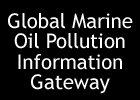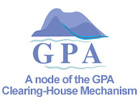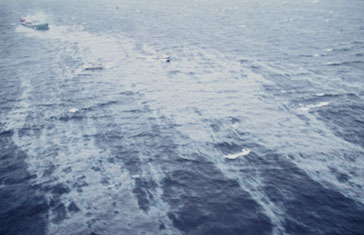| Regional
reports on the state of the marine and coastal environment

 Fourth Periodic Assessment of the Baltic Sea Environment:
Baltic Sea Environment 1994-1998". Summary.
Full
report. The amount of oil entering the Baltic Sea
every year has been estimated to be between 20,000 and
70,000 tonnes, about 10 per cent of which from shipping.
Fourth Periodic Assessment of the Baltic Sea Environment:
Baltic Sea Environment 1994-1998". Summary.
Full
report. The amount of oil entering the Baltic Sea
every year has been estimated to be between 20,000 and
70,000 tonnes, about 10 per cent of which from shipping.
 Marine
and Coastal Environment. Annual topic update 2000.
Report published in 2000 by the EEA
Topic Center on Marine and Coastal Environment.
Marine
and Coastal Environment. Annual topic update 2000.
Report published in 2000 by the EEA
Topic Center on Marine and Coastal Environment.
 EEA: State of the environment reporting system (SERIS):
Country
reports for Denmark, Estonia, Finland, Germany,
Latvia, Lithuania, Poland, Russian Federation, and Sweden.
EEA: State of the environment reporting system (SERIS):
Country
reports for Denmark, Estonia, Finland, Germany,
Latvia, Lithuania, Poland, Russian Federation, and Sweden.
 UNEP: Global
Environment Outlook 3 (GEO3). Coastal and marine
areas..
UNEP: Global
Environment Outlook 3 (GEO3). Coastal and marine
areas..
 University
of Rhode Island: Large Marine Ecosystems (LME): The
region includes the Baltic
Large Marine Ecosystem.
University
of Rhode Island: Large Marine Ecosystems (LME): The
region includes the Baltic
Large Marine Ecosystem.
Regional
conventions, agreements, action plans and actors
 Convention
of the Protection of the Marine Environment of the Baltic
Sea (Helsinki Convention) • Helsinki Commission
(HELCOM) • See also the HELCOM Copenhagen Declaration
on safety of navigation and emergency capacity in the
Baltic Sea Area. ••>
Convention
of the Protection of the Marine Environment of the Baltic
Sea (Helsinki Convention) • Helsinki Commission
(HELCOM) • See also the HELCOM Copenhagen Declaration
on safety of navigation and emergency capacity in the
Baltic Sea Area. ••>
 HELCOM Joint Comprehensive Environmental Action Programme.
••>
HELCOM Joint Comprehensive Environmental Action Programme.
••>
 HELCOM: Waste disposal in the Baltic Sea.
HELCOM: Waste disposal in the Baltic Sea.
 Baltic Strategy on Port Reception Facilities for Ship-generated
Wastes. ••>
Baltic Strategy on Port Reception Facilities for Ship-generated
Wastes. ••>
 Copenhagen Agreement. ••>
Copenhagen Agreement. ••>
 Baltic Sea Regional Project. ••>
Baltic Sea Regional Project. ••>
 Declaration
of the Joint Ministerial Meeting of the Helsinki and
OSPAR Commissions (June, 2003): Environmental
impact of shipping.
Declaration
of the Joint Ministerial Meeting of the Helsinki and
OSPAR Commissions (June, 2003): Environmental
impact of shipping.
 Paris
Memorandum of Understanding on Port State Control. ••>
Paris
Memorandum of Understanding on Port State Control. ••>

 Vision and Strategies around the Baltic Sea 2010: Maritime
Transport in the Baltic Sea from a Spatial Perspective.
Vision and Strategies around the Baltic Sea 2010: Maritime
Transport in the Baltic Sea from a Spatial Perspective.
International
actors and agreements in the region
 See
Global action and Global
actors.
See
Global action and Global
actors.
 The Baltic Sea has been designated as a Special
Area for the purpose of Annex I (oil) to MARPOL
73/78. Discussions are ongoing about applying also
for status as a Particularly Sensitive Sea Area (PSSA)
under MARPOL..
The Baltic Sea has been designated as a Special
Area for the purpose of Annex I (oil) to MARPOL
73/78. Discussions are ongoing about applying also
for status as a Particularly Sensitive Sea Area (PSSA)
under MARPOL..
 UNECE Convention of the Protection and Use of Transboundary
Watercourses and International Lakes. • UNECE.
••>
UNECE Convention of the Protection and Use of Transboundary
Watercourses and International Lakes. • UNECE.
••>
 UNEP Regional Office for Europe. ••>
UNEP Regional Office for Europe. ••>
 UNEP
Regional Seas Programme. ••>
UNEP
Regional Seas Programme. ••>
 UNEP Global programme of action for the protection of
the marine environment from land-based activities (UNEP
GPA). ••>
UNEP Global programme of action for the protection of
the marine environment from land-based activities (UNEP
GPA). ••>
|
National
action
 National
organization of response within the framework of the
EU Community Information System: Denmark
• Finland
• Germany
• Sweden.
National
organization of response within the framework of the
EU Community Information System: Denmark
• Finland
• Germany
• Sweden.
Denmark
Estonia
Finland
Germany
Latvia
Lithuania
Poland
Russia
Sweden
Private
sector and NGO actors and initiatives
 Baltic
Ports Organization (BPO). ••>
Baltic
Ports Organization (BPO). ••>
 Coalition Clean Baltic. ••>
Coalition Clean Baltic. ••>
 European
Sea Ports Organization (ESPO). ••>
European
Sea Ports Organization (ESPO). ••>
 European
Community Shipowners Association,
ECSA. See Annual
Report on Safety and Environment.
European
Community Shipowners Association,
ECSA. See Annual
Report on Safety and Environment.
 CONCAWE.
The oil companies' European organisation for environment,
health and safety.
CONCAWE.
The oil companies' European organisation for environment,
health and safety.
 Europia.
The European government affairs organisation of the
oil refining and marketing industry in the EU and EEA.
Europia.
The European government affairs organisation of the
oil refining and marketing industry in the EU and EEA.
 Oilwatch. ••>
Oilwatch. ••>
 International Tanker Owners Pollution Federation (ITOPF).
••>
International Tanker Owners Pollution Federation (ITOPF).
••>
 International Directory of Oil Spill Cleanup Contractors
and Response Organisations. ••>
International Directory of Oil Spill Cleanup Contractors
and Response Organisations. ••>
 International Petroleum Industry Environmental Conservation
Association (IPIECA). ••>
International Petroleum Industry Environmental Conservation
Association (IPIECA). ••>
|



